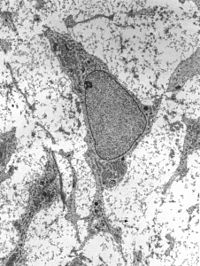
Photo from wikipedia
PURPOSE Suppressed osteogenic differentiation is considered a main cause of ethanol-induced osteonecrosis. Tumor necrosis factor α (TNF-α) and miR-31 have been reported to be involved in the osteogenic induction. This… Click to show full abstract
PURPOSE Suppressed osteogenic differentiation is considered a main cause of ethanol-induced osteonecrosis. Tumor necrosis factor α (TNF-α) and miR-31 have been reported to be involved in the osteogenic induction. This study aimed to explore a possible molecular mechanism regulating osteogenic differentiation in ethanol-induced osteonecrosis bone marrow stromal stem cells (BMSCs). METHODS Alizarin red staining was used to examine the level of mineralization in osteogenic differentiation process. Alkaline phosphatase assay was applied to the validation of ALP level which was essential to bone mineralization. The level of osteogenesis markers was determined by western blot assay, whereas the fluctuations of messenger RNA levels were tested by quantitative real-time polymerase chain reaction. Microarray analysis was conducted to identify differentially expressed genes, because the possible target relationship was predicted and validated by miRBase and luciferase reporter assay, respectively. Colony forming unit of fibroblast assay was used to observe the proliferation of BMSCs. RESULTS BMSCs from patients with ethanol-induced osteonecrosis exhibited weaker osteogenic differentiation and proliferation abilities. TNF-α inhibitor added in the osteogenic medium significantly enhanced the osteogenic differentiation ability and BMSCs proliferation ability. TNF-α by regulating miR-31 downregulated the expressions of RUNX2 and SATB2, two contributors of osteoblast differentiation, further suppressed osteogenic differentiation. On the contrary, TNF-α inhibitor could promote osteogenic differentiation in BMSCs from patients with ethanol-induced osteonecrosis. CONCLUSION TNF-α inhibitor could downregulate miR-31 expressions, which directly promoted SATB2 and RUNX2 expressions and enhanced osteogenic differentiation of BMSCs from patients with ethanol-induced osteonecrosis.
Journal Title: Journal of cellular physiology
Year Published: 2019
Link to full text (if available)
Share on Social Media: Sign Up to like & get
recommendations!